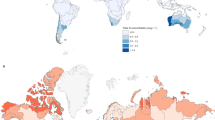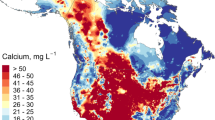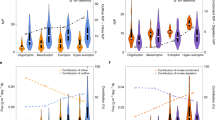Abstract
Excess phosphorus from agricultural intensification has contributed to the eutrophication of rivers and lakes worldwide, including the transboundary Laurentian Great Lakes Basin. Algal blooms have surged in the past decade, threatening ecosystems, drinking water supplies and lake-dependent tourism economies in both large lakes (for example, Lake Erie) and smaller water bodies. Whereas previous research has focused mainly on phosphorus loads to Lake Erie, a comprehensive analysis of phosphorus species across the basin is lacking. Here we analyse changes in soluble reactive phosphorus and total phosphorus concentrations in over 370 watersheds across the Great Lakes Basin from 2003 to 2019. We find widespread increases in soluble phosphorus concentrations (83% of watersheds, with 46% showing significant increase), while total phosphorus concentrations are decreasing or non-significant. Utilizing random forest models, we identify small, forested watersheds at higher latitudes as the areas experiencing the largest relative increases in soluble phosphorus concentrations. Furthermore, we find winter temperatures to be a key driver of winter concentration trends. We propose that the increasing soluble phosphorus concentrations across the basin, along with warming temperatures, might be contributing to the increasing frequency and intensity of algal blooms, emphasizing the need for management strategies to prevent further water-quality degradation.
This is a preview of subscription content, access via your institution
Access options
Access Nature and 54 other Nature Portfolio journals
Get Nature+, our best-value online-access subscription
$29.99 / 30 days
cancel any time
Subscribe to this journal
Receive 12 print issues and online access
$259.00 per year
only $21.58 per issue
Buy this article
- Purchase on Springer Link
- Instant access to full article PDF
Prices may be subject to local taxes which are calculated during checkout





Similar content being viewed by others
Data availability
Phosphorus (total and orthophosphate-P) concentrations can be obtained from https://data.ontario.ca/dataset/provincial-stream-water-quality-monitoring-network (Canada) and https://waterdata.usgs.gov/nwis (United States). Flow datasets are available from https://wateroffice.ec.gc.ca/mainmenu/historical_data_index_e.html (Canada) and https://waterdata.usgs.gov/nwis/dv/?referred_module=sw (United States). Monthly climate (precipitation totals, minimum and maximum air temperatures) datasets for Canada and the United States are available through https://doi.org/10.3334/ORNLDAAC/2131. Land-use land-cover maps are available from https://open.canada.ca/data/en/dataset/3688e7d9-7520-42bd-a3eb-8854b685fef3 (Canada) and https://www.sciencebase.gov/catalog/item/5d4c6a1de4b01d82ce8dfd2f (United States). Tillage datasets are available from https://www150.statcan.gc.ca/n1/en/type/data?MM=1 (Canada) and https://www.ctic.org/CRM (United States). Tile-drainage maps are available from https://geohub.lio.gov.on.ca/datasets/lio::tile-drainage-area/about (Canada) and https://figshare.com/articles/dataset/AgTile-US/11825742 (United States). Soils texture datasets are available from https://www.fao.org/soils-portal/data-hub/soil-maps-and-databases/harmonized-world-soil-database-v12/en/ (Canada) and https://water.usgs.gov/GIS/metadata/usgswrd/XML/ds866_ssurgo_variables.xml#stdorder (United States). Population data can be downloaded from https://www12.statcan.gc.ca/census-recensement/2011/dp-pd/index-eng.cfm (Canada) and https://www.census.gov/programs-surveys/decennial-census/decade.2010.html (United States). Great Lakes Basin map can be obtained from https://www.glc.org/greatlakesgis.
References
Ho, J. C., Michalak, A. M. & Pahlevan, N. Widespread global increase in intense lake phytoplankton blooms since the 1980s. Nature 574, 667–670 (2019).
Hou, X. et al. Global mapping reveals increase in lacustrine algal blooms over the past decade. Nat. Geosci. 15, 130–134 (2022).
Van Meter, K. J., Van Cappellen, P. & Basu, N. B. Legacy nitrogen may prevent achievement of water quality goals in the Gulf of Mexico. Science 360, 427–430 (2018).
Stackpoole, S. M., Stets, E. G. & Sprague, L. A. Variable impacts of contemporary versus legacy agricultural phosphorus on US river water quality. Proc. Natl Acad. Sci. USA 116, 20562–20567 (2019).
Basu, N. B. et al. Managing nitrogen legacies to accelerate water quality improvement. Nat. Geosci. 15, 97–105 (2022).
Dolan, D. M. & Chapra, S. C. Great Lakes total phosphorus revisited: 1. loading analysis and update (1994–2008). J. Great Lakes Res. 38, 730–740 (2012).
Scavia, D. et al. Assessing and addressing the re-eutrophication of Lake Erie: central basin hypoxia. J. Great Lakes Res. 40, 226–246 (2014).
Watson, S. B. et al. The re-eutrophication of Lake Erie: harmful algal blooms and hypoxia. Harmful Algae 56, 44–66 (2016).
Stow, C. A., Cha, Y., Johnson, L. T., Confesor, R. & Richards, R. P. Long-term and seasonal trend decomposition of maumee river nutrient inputs to western Lake Erie. Environ. Sci. Technol. 49, 3392–3400 (2015).
Favot, E. J., Holeton, C., DeSellas, A. M. & Paterson, A. M. Cyanobacterial blooms in Ontario, Canada: continued increase in reports through the 21st century. Lake Reservoir Manage. https://doi.org/10.1080/10402381.2022.2157781 (2022).
Sterner, R. W., Reinl, K. L., Lafrancois, B. M., Brovold, S. & Miller, T. R. A first assessment of cyanobacterial blooms in oligotrophic Lake Superior. Limnol. Oceanogr. 65, 2984–2998 (2020).
Great Lakes Water Quality Agreement Protocol Amending the Agreement Between Canada and the United States (The Government of Canada and the Government of the United States of America, 2012); https://www.canada.ca/en/environment-climate-change/services/great-lakes-protection/2012-water-quality-agreement.html
Han, H., Allan, D. J. & Bosch, N. S. Historical pattern of phosphorus loading to Lake Erie watersheds. J. Great Lakes Res. 38, 289–298 (2012).
Baker, D. B. et al. Phosphorus loading to Lake Erie from the Maumee, Sandusky and Cuyahoga rivers: the importance of bioavailability. J. Great Lakes Res. 40, 502–517 (2014).
Jarvie, H. P. et al. Increased soluble phosphorus loads to lake Erie: unintended consequences of conservation practices? J. Environ. Qual. 46, 123–132 (2017).
Mooney, R. J. et al. Outsized nutrient contributions from small tributaries to a Great Lake. Proc. Natl Acad. Sci. USA 117, 28175–28182 (2020).
Winter, J. G. et al. Phosphorus inputs to Lake Simcoe from 1990 to 2003: declines in tributary loads and observations on lake water quality. J. Great Lakes Res. 33, 381–396 (2007).
Stammler, K. L., Taylor, W. D. & Mohamed, M. N. Long-term decline in stream total phosphorus concentrations: a pervasive pattern in all watershed types in Ontario. J. Great Lakes Res. 43, 930–937 (2017).
Catherine Eimers, M., Watmough, S. A., Paterson, A. M., Dillon, P. J. & Yao, H. Long-term declines in phosphorus export from forested catchments in south-central Ontario. Can. J. Fish. Aquat. Sci. 66, 1682–1692 (2009).
O’Brien, H. D., Eimers, M. C., Watmough, S. A. & Casson, N. J. Spatial and temporal patterns in total phosphorus in south-central Ontario streams: the role of wetlands and past disturbance. Can. J. Fish. Aquat. Sci. 70, 766–774 (2013).
Kendall, M. G. Rank Correlation Methods. 4th ed. (Griffin, 1970).
Wong, W. H. et al. Declining ambient water phosphorus concentrations in Massachusetts’ rivers from 1999 to 2013: environmental protection works. Water Res. 139, 108–117 (2018).
Stoddard, J. L. et al. Continental-scale increase in lake and stream phosphorus: are oligotrophic systems disappearing in the United States? Environ. Sci. Technol. 50, 3409–3415 (2016).
Carleton, J. N. & Washington, B. J. Assessing evidence of phosphorus concentration trends in North American freshwaters. J. Am. Water Resour. Assoc. 57, 956–971 (2021).
Van Meter, K. J., Chowdhury, S., Byrnes, D. K. & Basu, N. B. Biogeochemical asynchrony: ecosystem drivers of seasonal concentration regimes across the Great Lakes Basin. Limnol. Oceanogr. 65, 848–862 (2020).
Dodds, W. K., Jones, J. R. & Welch, E. B. Suggested classification of stream trophic state: distributions of temperate stream types by chlorophyll, total nitrogen, and phosphorus. Water Res. 32, 1455–1462 (1998).
Raney, S. M. & Eimers, M. C. Unexpected declines in stream phosphorus concentrations across southern Ontario. Can. J. Fish. Aquat. Sci. 71, 337–342 (2014).
Boland-Brien, S. J., Basu, N. B. & Schilling, K. E. Homogenization of spatial patterns of hydrologic response in artificially drained agricultural catchments. Hydrol. Process. 28, 5010–5020 (2014).
Basu, N. B., Thompson, S. E. & Rao, P. S. C. Hydrologic and biogeochemical functioning of intensively managed catchments: a synthesis of top-down analyses. Water Resour. Res. https://doi.org/10.1029/2011WR010800 (2011).
Daryanto, S., Wang, L. & Jacinthe, P. A. Meta-analysis of phosphorus loss from no-till soils. J. Environ. Qual. 46, 1028–1037 (2017).
Macrae, M. et al. One size does not fit all: toward regional conservation practice guidance to reduce phosphorus loss risk in the Lake Erie watershed. J. Environ. Qual. 50, 529–546 (2021).
Musolff, A., Selle, B., Büttner, O., Opitz, M. & Tittel, J. Unexpected release of phosphate and organic carbon to streams linked to declining nitrogen depositions. Glob. Change Biol. 23, 1891–1901 (2017).
Rixon, S., Levison, J., Binns, A. & Persaud, E. Spatiotemporal variations of nitrogen and phosphorus in a clay plain hydrological system in the Great Lakes Basin. Sci. Total Environ. 714, 136328 (2020).
Seybold, E. C. et al. Winter runoff events pose an unquantified continental-scale risk of high wintertime nutrient export. Environ. Res. Lett. 17, 104044 (2022).
Macrae, M. L., English, M. C., Schiff, S. L. & Stone, M. Intra-annual variability in the contribution of tile drains to basin discharge and phosphorus export in a first-order agricultural catchment. Agric. Water Manag. 92, 171–182 (2007).
Van Meter, K. J. et al. Beyond the mass balance: watershed phosphorus legacies and the evolution of the current water quality policy challenge. Water Resour. Res. 57, e2020WR029316 (2021).
Van Staden, T. L. et al. Agricultural phosphorus surplus trajectories for Ontario, Canada (1961–2016), and erosional export risk. Sci. Total Environ. 818, 151717 (2022).
Norton, P. A., Driscoll, D. G. & Carter, J. M. Climate, streamflow, and lake-level trends in the Great Lakes Basin of the United States and Canada, water years 1960–2015 Scientific Investigations Report (USGS, 2019); https://doi.org/10.3133/SIR20195003
Singh, N. K. & Basu, N. B. The human factor in seasonal streamflows across natural and managed watersheds of North America. Nat. Sustain. 5, 397–405 (2022).
Basu, N. B., Dony, J., Van Meter, K. J., Johnston, S. J. & Layton, A. T. A random forest in the Great Lakes: stream nutrient concentrations across the transboundary Great Lakes Basin. Earth’s Future 11, e2021EF002571 (2023).
Ontario Ministry of Environment. Provincial (stream) water quality monitoring network. https://data.ontario.ca/dataset/provincial-stream-water-quality-monitoring-network (Government of Ontario, 2020).
Historical hydrometric data website. Environment and Climate Change Canada https://wateroffice.ec.gc.ca/mainmenu/historical_data_index_e.html (2020).
Water data for the nation. USGS https://waterdata.usgs.gov/nwis? (2020).
Hirsch, R. M. & De Cicco, L. User Guide to Exploration and Graphics for RivEr Trends (EGRET) and dataRetrieval: R Packages for Hydrologic Data Techniques and Methods 4-A10 (USGS, 2015); https://doi.org/10.3133/tm4A10
Kendall, M. G. Rank correlation methods (Griffin, 1975).
Sen, P. K. Estimates of the regression coefficient based on Kendall’s Tau. J. Am. Stat. Assoc. 63, 1379–1389 (1968).
Bhattacharya, R. et al. Nonlinear multidecadal trends in organic matter dynamics in Midwest reservoirs are a function of variable hydroclimate. Limnol. Oceanogr. 67, 2531–2546 (2022).
Hamed, K. H. & Ramachandra Rao, A. A modified Mann–Kendall trend test for autocorrelated data. J. Hydrol. 204, 182–196 (1998).
Amrhein, V., Greenland, S. & McShane, B. Scientists rise up against statistical significance. Nature 567, 305–307 (2019).
Biau, G. & Scornet, E. A random forest guided tour. Test 25, 197–227 (2016).
Friedman, J. H. Greedy function approximation: a gradient boosting machine. Ann. Stat. 29, 1189–1232 (2001).
Acknowledgements
The research published in this paper was supported by the ‘Lake Futures’ project under the Global Water Futures programme, funded by the Canada First Research Excellence Fund. We thank B. Tolson and M. Han at University of Waterloo for access to and advice regarding data published in https://lake-river-routing-products-uwaterloo.hub.arcgis.com/.
Author information
Authors and Affiliations
Contributions
N.K.S., N.B.B. and K.J.V.M. conceptualized the project. N.K.S. conducted the analyses. N.K.S. and N.B.B. analysed the figures and results. N.K.S., N.B.B. and K.J.V.M. wrote the manuscript. N.B.B. supervised and acquired funding.
Corresponding author
Ethics declarations
Competing interests
The authors declare no competing interests.
Peer review
Peer review information
Nature Geoscience thanks Robert Mooney and the other, anonymous, reviewer(s) for their contribution to the peer review of this work. Primary Handling Editor: Xujia Jiang, in collaboration with the Nature Geoscience team.
Additional information
Publisher’s note Springer Nature remains neutral with regard to jurisdictional claims in published maps and institutional affiliations.
Extended data
Extended Data Fig. 1 Seasonal total phosphorus (a-d) and soluble reactive phosphorus (e-h) concentrations over the last five years across the Great Lakes Basin.
Winter (a, e), Spring (b, f), Summer (c, g), Fall (d, h). Violin plots show the distributions of seasonal concentrations for (a-d) TP and (e-h) SRP across the six major subbasins (see Supplementary Fig. 1 for basin locations). Number of streams in each subbasin is denoted by n. Within the violins, white-filled circles show the median value, thick lines the interquartile range, and whiskers extend to a maximum of 1.5 times the interquartile range. The dashed lines indicate the eutrophic threshold of 76 μg l−1 for TP (a-d) and 50 μg l−1 for SRP (e-h).
Extended Data Fig. 2 The distribution of land use across the Great Lakes Basin.
We categorized the land use and land cover maps (Canada and the United States; Supplementary Table 3) into four classes21: Urban [Urban >12.5% & Crop <25% & (Crop + Pasture) < 30% & Undeveloped <70%], Forested/Undeveloped [(Forest+BarrenLand+Shrubland+Wetland+OpenWater+Grassland)>70%], Agricultural (Crop>12.5%) & (Crop +Pasture>40%) & (Undeveloped <70%), and Mixed [watersheds that do not fall into first three classes].Mixed [watersheds that do not fall into first three classes].
Extended Data Fig. 3 The distribution of watershed typologies across the Great Lakes Basin.
Quadrant 1 indicates watersheds where both SRP and TP are increasing, Quadrant 2 indicates watersheds where SRP is increasing and TP is decreasing, Quadrant 3 indicates watersheds where both SRP and TP are decreasing, and Quadrant 4 indicates watersheds where SRP is decreasing and TP is increasing. Typologies are for all watersheds with significant (p < 0.05) or non-significant (p > 0.05) trends in concentrations.
Extended Data Fig. 4 The distribution of (a) population density and (b) forest coverage across the three typologies of trends.
Note that we focused only on watersheds with significant trends, and thus Quadrant 4 is not presented. Violin plots show the distributions of observations with significant trends (p < 0.05), white-filled circles show the medians, thick lines the interquartile range, and whiskers extend to a maximum of 1.5 times the interquartile range. Sample sizes for (a) and (b): Quadrant 1 (n = 14), Quadrant 2 (n = 23) and Quadrant 3 (n = 17).
Extended Data Fig. 5 Distribution of watersheds with forest area and mean topographic slope along the latitudinal gradient.
Larger size of circles indicates greater forest cover. Overall, forest cover is greater at higher latitudes in our study watersheds.
Extended Data Fig. 6 Variable importance plots for seasonal concentrations of total phosphorus and soluble reactive phosphorus.
The ranked importance of key predictors for (a–d) total phosphorus and (e–h) soluble reactive phosphorus seasonally across 100 (n) model runs is represented by box and whisker plots, which show the median values (horizontal line in each box), the interquartile range (width of the box), and the whiskers that extend to a maximum of 1.5 times the interquartile range. Adjacent boxes of the same color indicate that there is no significant difference in importance between those predictors (p < 0.05) (Supplementary Data).
Supplementary information
Supplementary Information
Supplementary Tables 1–3, Figs. 1–3 and References for Supplementary Tables.
Supplementary Data
Anova p values for RF models of SRP and TP concentrations.
Rights and permissions
Springer Nature or its licensor (e.g. a society or other partner) holds exclusive rights to this article under a publishing agreement with the author(s) or other rightsholder(s); author self-archiving of the accepted manuscript version of this article is solely governed by the terms of such publishing agreement and applicable law.
About this article
Cite this article
Singh, N.K., Van Meter, K.J. & Basu, N.B. Widespread increases in soluble phosphorus concentrations in streams across the transboundary Great Lakes Basin. Nat. Geosci. 16, 893–900 (2023). https://doi.org/10.1038/s41561-023-01257-5
Received:
Accepted:
Published:
Issue Date:
DOI: https://doi.org/10.1038/s41561-023-01257-5



